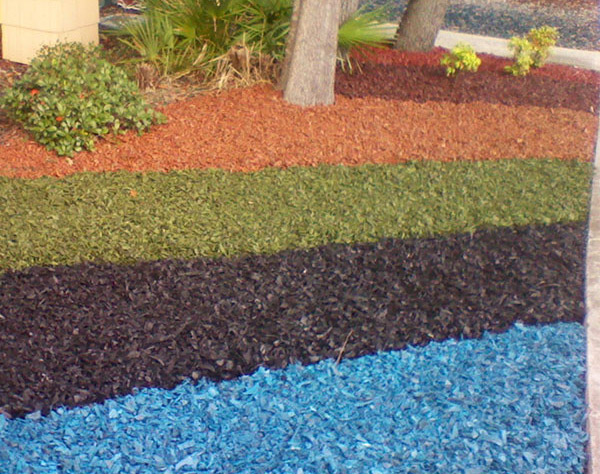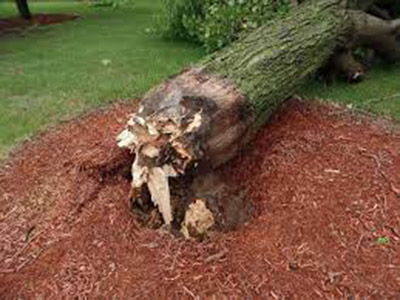Mulching The Landscape - Sit Down with CEPRA
Mulch is key to tying together the overall neat appearance of a landscape. Mulch is typically used to cover the soil in a landscape bed or garden, but it does much more than just that. Mulch adds vibrant color and texture, giving your ornamental beds a uniform, well-maintained look by adding definition between the turf grass and ornamental beds. When setting out to mulch your property, choosing to use a particular mulch is as much about appearances as it is about the health of the landscape.
Mulching is naturally occurring in nature, appearing as fallen leaves, needles, twigs, pieces of bark, spent flowers, fallen fruit and other organic materials. In the landscape, mulch is typically more uniform, deriving from trees such as pine or cypress. Mulch can also consist of stone, crushed rock, and other inorganic materials. Both have their benefits and drawbacks. When selecting a mulch, consider not only the cost and color, but also origin and durability.
Benefits of Mulch
- Mulch prevents loss of water from the soil by evaporation.
- Mulch can aid in protecting plants by serving as an insulating blanket that helps keep soil warmer in the winter and cooler in the summer.
- Mulch is a useful anti-weed device when applied at a depth of 2-3". By adding it to your shrub beds, it prevents the sunlight from reaching the soil, which reduces weed seeds from sprouting.
- Mulch improves the soil's aeration, structure, and drainage.
- Mulch made from organic materials improves the soil's ability to hold nutrients, by adding organic nutrients as the mulch decomposes.
- Mulch prevents the soil from "splashing," which is when soil is dispersed to its surrounding similar to splashing a pool of water. This reduces erosion and keeps soil-borne diseases from splattering onto the leaves of plants.
- Mulch protects trunks of trees, fences, poles, and other obstacles found in the landscape from damage by lawn equipment.
Mulch Types - Organic vs Inorganic
Organic mulches are made from a natural material such as bark, wood chips, or pine needles. Over time these materials will break down, decompose, and add to the makeup of the soil.
Pine Bark - This is a lightweight mulch byproduct of the forest industry. It is long lasting and comes in many different sizes, called nuggets. This mulch has an attractive rich brown color. It tends to be more buoyant that other types of much, with the larger sized nuggets tending to float or get displaced in a heavy rain.

Large Pine Bark Nuggets

Mini Pine Bark Nuggets

Pine Bark Fines
Pine Straw (Needles) - This is a byproduct from pine tree plantations. It brings a very natural look to the landscape. Pine straw is not likely to become displaced in a heavy rain event. It tends to break down quicker than other organic mulches and may require more frequent replacement. It is an excellent mulch selection for acid-loving trees and plants, such as azaleas and rhododendrons.

Pine Straw Rolls

Pine Straw Bales
Hardwood - This mulch is produced from scrap lumber, recycled pallets, and tree branches too small to be used in manufacturing. Hardwood mulches are synthetically dyed to add red, brown, black, or gold color to the landscape. But be aware that the colors will fade over time. This mulch does not wash away easily, decomposes relatively slowly, and is very attractive.

Additional Organic Mulch Sources
Fallen Leaves - This mulch is high in nutrients but decomposes quickly. It brings a very natural look to the landscape.
Melaleuca Mulch - This mulch is made from an exotic evasive tree. The mulched parts from the tree are cured at a high temperature to prevent seed germination.
Eucalyptus Mulch - Special Eucalyptus tree plantations located in South and Central Florida are specially grown to provide a finely-shredded wood chips-style mulch.
Inorganic mulches are synthetic or natural materials that do not break down in the landscape. They will last a long time but do nothing to improve the soil - and can become a nuisance if they become displaced in the landscape.
Rubber Mulch - Rubber mulch generally consists of either waste tire bits or nuggets of synthetic rubber from tires that are either shredded or ground up whole, after having their steel bands removed. It is less effective than organic mulches with suppressing weeds and it absorbs heat, leading to extremely high soil temperatures. Coming in a wide range of colors, it can be used in both landscape and playground locations.

Gravel, Pebbles & Crushed Rock - These mulch sources will not contribute to the soils nutrient content or water holding capacity. These will sink into sandy soils and need to be regularly cleared of debris to look their best. They are very durable but reflect heat, creating a very hot landscape in the summer months. They are tough to remove once placed into the landscape.

Landscape Cloth - This is a woven plastic fabric that is treated to resist decomposition. It is effective in controlling most weeds with used in conjunction with an organic mulch material.

Timing Your Mulch Application
Although you can mulch at any time during the year, typically, the best time to mulch your landscape is after deciduous tree leaf drop, after ornamental plant cutbacks/rejuvenations are complete (generally in early spring), or after plant installation and upgrades are made to the landscape. How often mulch needs to be replenished will depend upon the mulching material selected. As the landscape matures, you will need less mulch from year to year. Mulch build-ups do occur over the years, so ensure your mulching plan includes a "removal and replace" strategy to clean out the beds and add fresh mulch once the current beds get too high.
Mulching Techniques
When applying mulch in ornamentals and ground covers beds, keep the mulch away from the stems or "crown" of the plants. Excessive or burrowing your plants in mulch will foster crown and root rot disease, causing plant decline and/or death.
Avoid "Volcano Mulching." This is when mulch is piled up against the base of a tree covering the root flare. The excess mulch will encourage girdling roots, suffocate the root system over time, promote pathogen activity, and can lead to the ultimate failure of the tree.

"Volcano Mulching"

Failure of tree from excessive mulch
Conclusion
Mulch is key to improving the curb appeal of your landscape. There are a variety of mulch types to choose from, and these options are tailored to the needs of your home and community. From organic to inorganic, mulch helps provide for the plants in the landscape, as well as provide for the users of the landscape. With proper installation and care, the mulch will be a desired addition to your stunning landscape.
